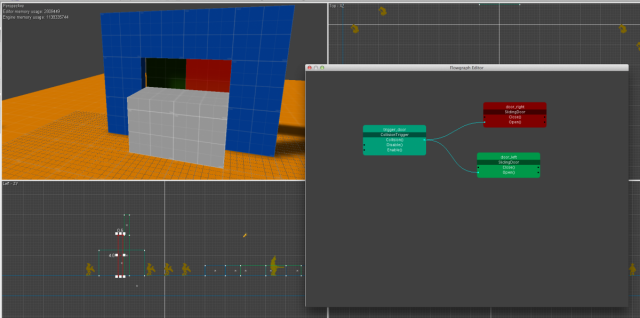Gameplay!
The Leadwerks community project "Midnight Salsa" was one of my favorite things that came out of Leadwerks 2. Watching the videos of everyone collaborating across the globe was really interesting, and with Aggror's leadership they did pull off what they set out to do: Make a playable zombie FPS. However, there were some weak points that showed me where I could put effort and have it be the most useful.
When you go through the first set of doors, a carefully placed light above the door shines to illuminate a sitting zombie as the doors open. I noticed right away the animation transitions weren't completely smooth. Although our animation system makes it very easy to transition between frames and do all sorts of interesting things, the logic that manages multiple animation sequences blending in and out can get a little messy. I approached this as a general problem and wrote an animation manager script in Lua that handles a "stack" of animations. When you set a new animation sequence, it is added to the top of the stack and blended in over a specified amount of time. Once it is completely blended in, all animations beneath it in the stack are removed. This process can handle any number of transitions smoothly, so you can just always set the latest one and there will never be more than two or three sequences active in the stack.
The second problem that affects a lot of people is AI. How do you get characters to go where you want them to go? My advice in the past was to implement a system of connected nodes, as I did in my game "Metal". I finally solved this problem once and for all with a relatively recent technique called navmesh pathfinding. This provides more accurate pathfinding that isn't limited to node points, and it's completely dynamic. If the level changes, the pathfinding adjusts to it. This level of integration is only possible because Leadwerks 3 was built with pathfinding baked into the core, and it makes it very easy to use. Implementing this system was a huge investment of time and effort, and there was no guarantee it would have succeeded, so it probably wasn't conceivable to add this on top of Leadwerks 2. In retrospect, I really should have built node-based pathfinding into Leadwerks 2 so we could all have a common foundation for AI.
In this video, the project leader mentions having to send the level model back to the artist for resizing. This causes a delay in progress while everyone waits for the new model. Our new CSG level design tools eliminate this problem because the map can be immediately adjusted right in the editor, without any waiting around or reimporting. Even if the artist wanted to take their time to make it perfect, a quick modification could be made to give the other team members something to test with. When combined with the built-in navmesh pathfinding, you can visualize the navigable areas as you build the level. There's never any guessing or going back to redo things because your enemies don't have room to get through a hallway or something.
Finally, there is the matter of game object interaction. Sometimes you have special interactions in a map, and abstract classes aren't always the best way to manage that. In the past, gameplay mechanics like doors, switches, were exclusively the domain of expert programmers. Although Leadwerks 2 had a built-in messaging system, too much was left undefined. Consequently, even the programmers who were able to implement advanced interactions each isolated themselves from the community of developers, because they were branching the engine. Our new flowgraph system provides a shared framework we can all utilize and share code within. This means reusable scripts can be written that can be used in many games, by many developers, and our scripts can "talk" to each other through the flow graph. In the map below I've set up a collision trigger (shown in grey) and attached it to two doors (shown in green). When the player walks into the collision trigger the doors open. This simple example shows how anybody can set up advanced game interactions in their map.
Our primary focus for Leadwerks 3 is delivering gameplay. I think all of these features will facilitate collaboration and give the community some much needed high-level frameworks. Not only does it make building games faster, it gives us all a common framework to work together within.
-
 8
8





17 Comments
Recommended Comments